Law Assignment: Contract, Insurance, Consumer, and Business Law
VerifiedAdded on 2020/04/15
|8
|1258
|82
Homework Assignment
AI Summary
This law assignment solution addresses various aspects of law, encompassing contract, insurance, and consumer law. Part A consists of multiple-choice questions testing knowledge of legal entities, insurance, and negotiable instruments. Part B provides detailed answers to case studies, focusing on unfair contract terms, misleading conduct, and breaches of the Australian Consumer Law. The answers analyze scenarios involving retail contracts, real estate agents, and insurance policies, explaining legal principles and relevant case references. The assignment covers topics such as the L'Estrange Rule, misleading or deceptive conduct, unconscionable conduct, and the rights and obligations of insured parties under the Insurance Act.
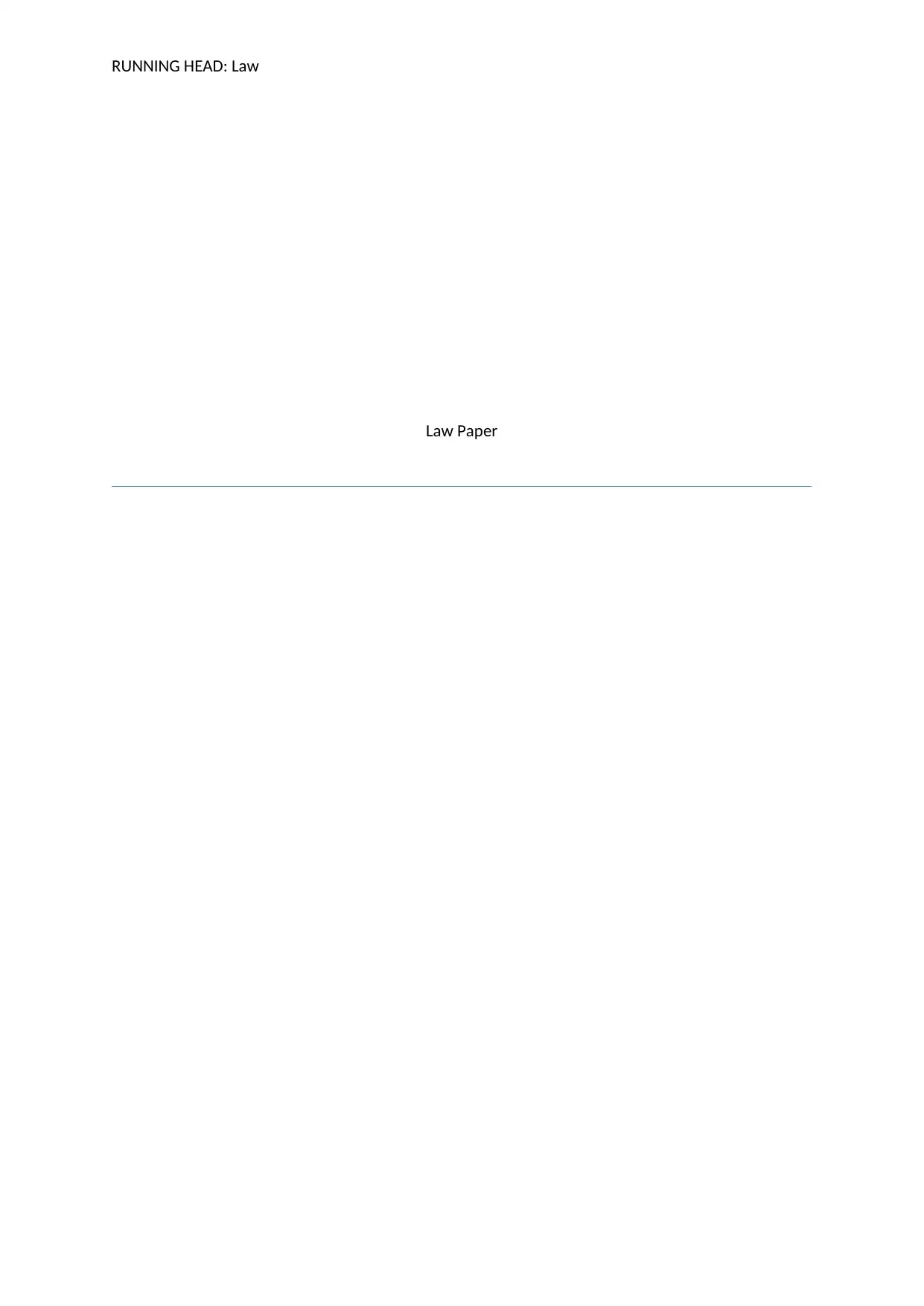
RUNNING HEAD: Law
Law Paper
Law Paper
Paraphrase This Document
Need a fresh take? Get an instant paraphrase of this document with our AI Paraphraser
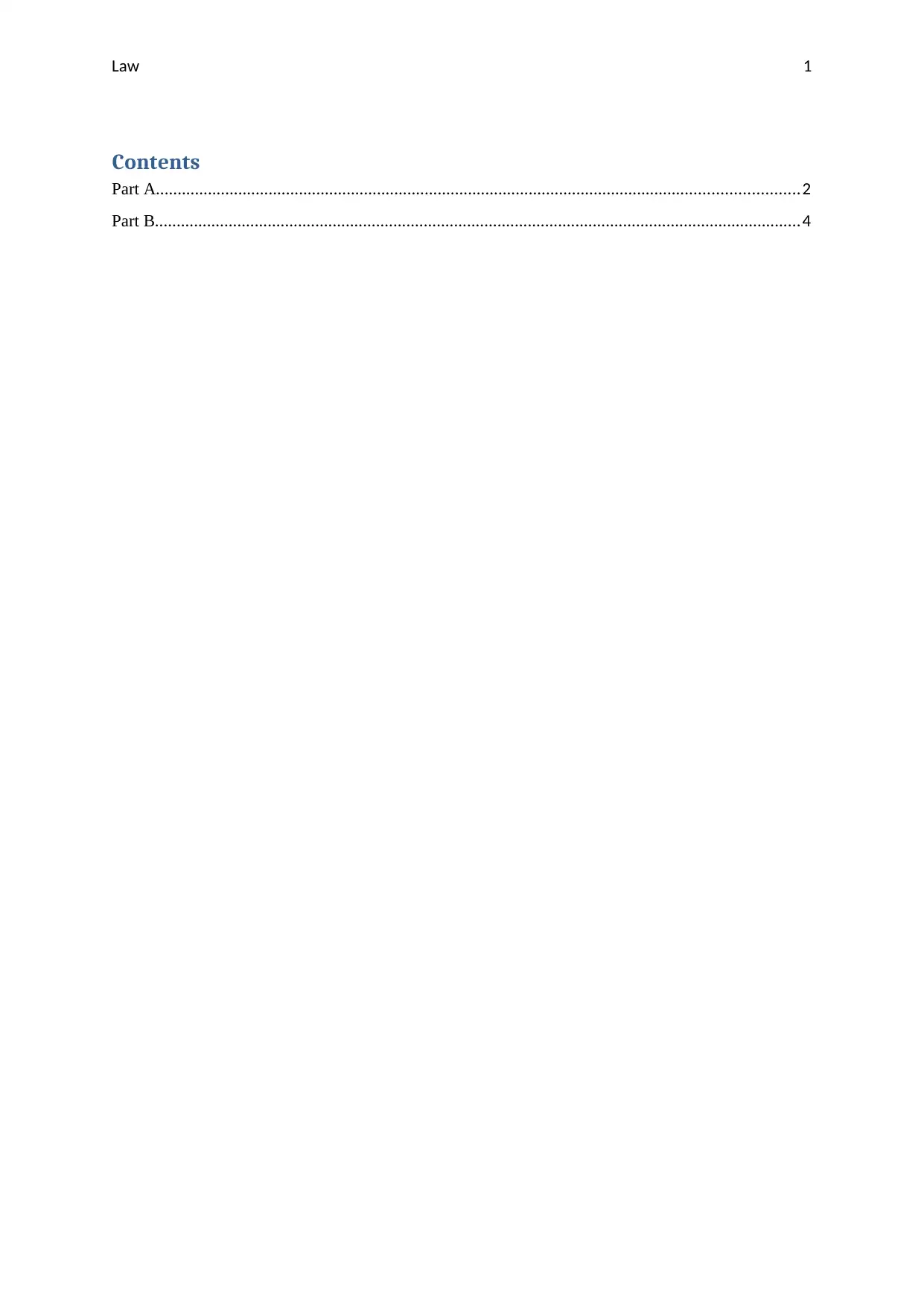
Law 1
Contents
Part A....................................................................................................................................................2
Part B.....................................................................................................................................................4
Contents
Part A....................................................................................................................................................2
Part B.....................................................................................................................................................4
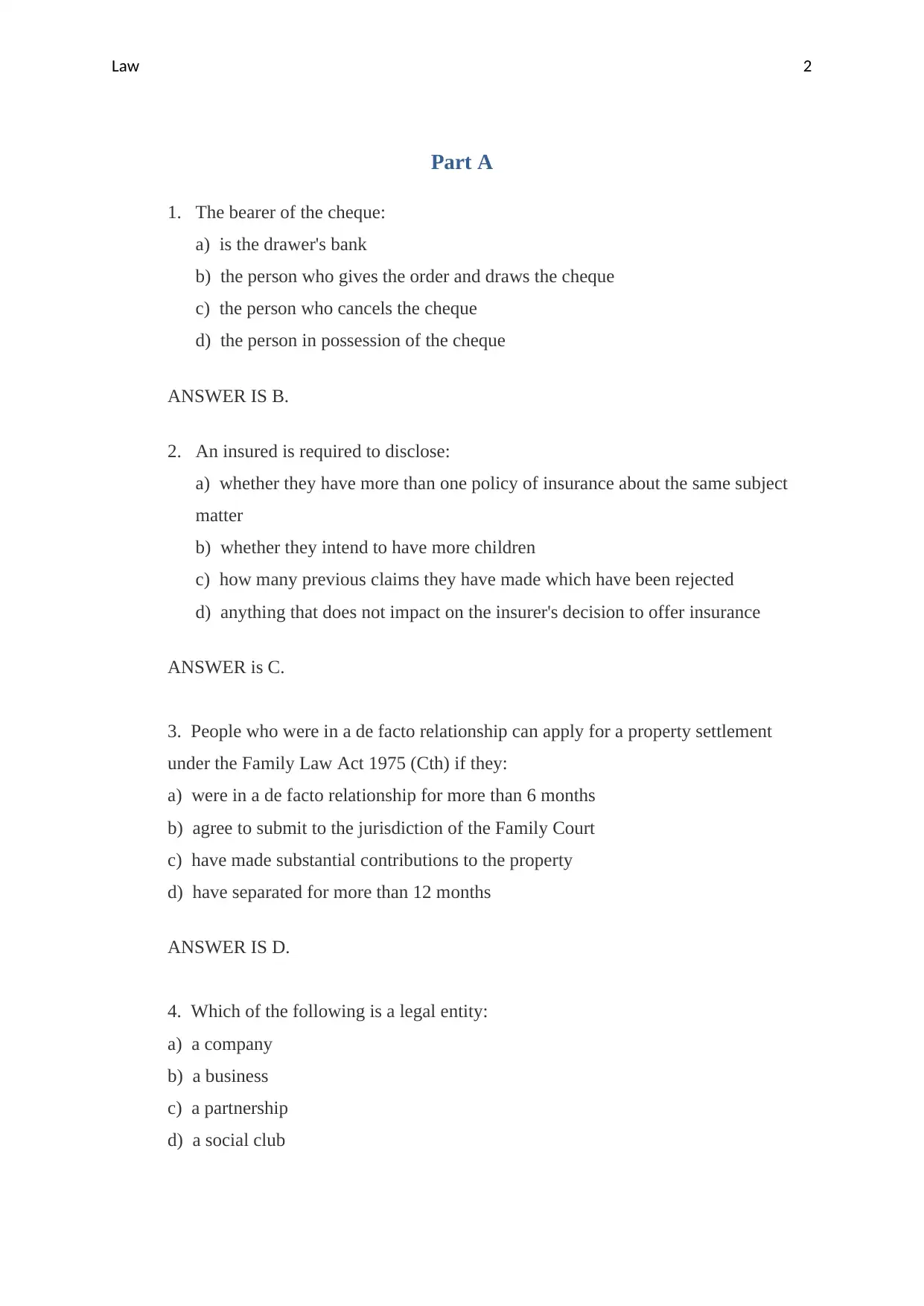
Law 2
Part A
1. The bearer of the cheque:
a) is the drawer's bank
b) the person who gives the order and draws the cheque
c) the person who cancels the cheque
d) the person in possession of the cheque
ANSWER IS B.
2. An insured is required to disclose:
a) whether they have more than one policy of insurance about the same subject
matter
b) whether they intend to have more children
c) how many previous claims they have made which have been rejected
d) anything that does not impact on the insurer's decision to offer insurance
ANSWER is C.
3. People who were in a de facto relationship can apply for a property settlement
under the Family Law Act 1975 (Cth) if they:
a) were in a de facto relationship for more than 6 months
b) agree to submit to the jurisdiction of the Family Court
c) have made substantial contributions to the property
d) have separated for more than 12 months
ANSWER IS D.
4. Which of the following is a legal entity:
a) a company
b) a business
c) a partnership
d) a social club
Part A
1. The bearer of the cheque:
a) is the drawer's bank
b) the person who gives the order and draws the cheque
c) the person who cancels the cheque
d) the person in possession of the cheque
ANSWER IS B.
2. An insured is required to disclose:
a) whether they have more than one policy of insurance about the same subject
matter
b) whether they intend to have more children
c) how many previous claims they have made which have been rejected
d) anything that does not impact on the insurer's decision to offer insurance
ANSWER is C.
3. People who were in a de facto relationship can apply for a property settlement
under the Family Law Act 1975 (Cth) if they:
a) were in a de facto relationship for more than 6 months
b) agree to submit to the jurisdiction of the Family Court
c) have made substantial contributions to the property
d) have separated for more than 12 months
ANSWER IS D.
4. Which of the following is a legal entity:
a) a company
b) a business
c) a partnership
d) a social club
⊘ This is a preview!⊘
Do you want full access?
Subscribe today to unlock all pages.

Trusted by 1+ million students worldwide
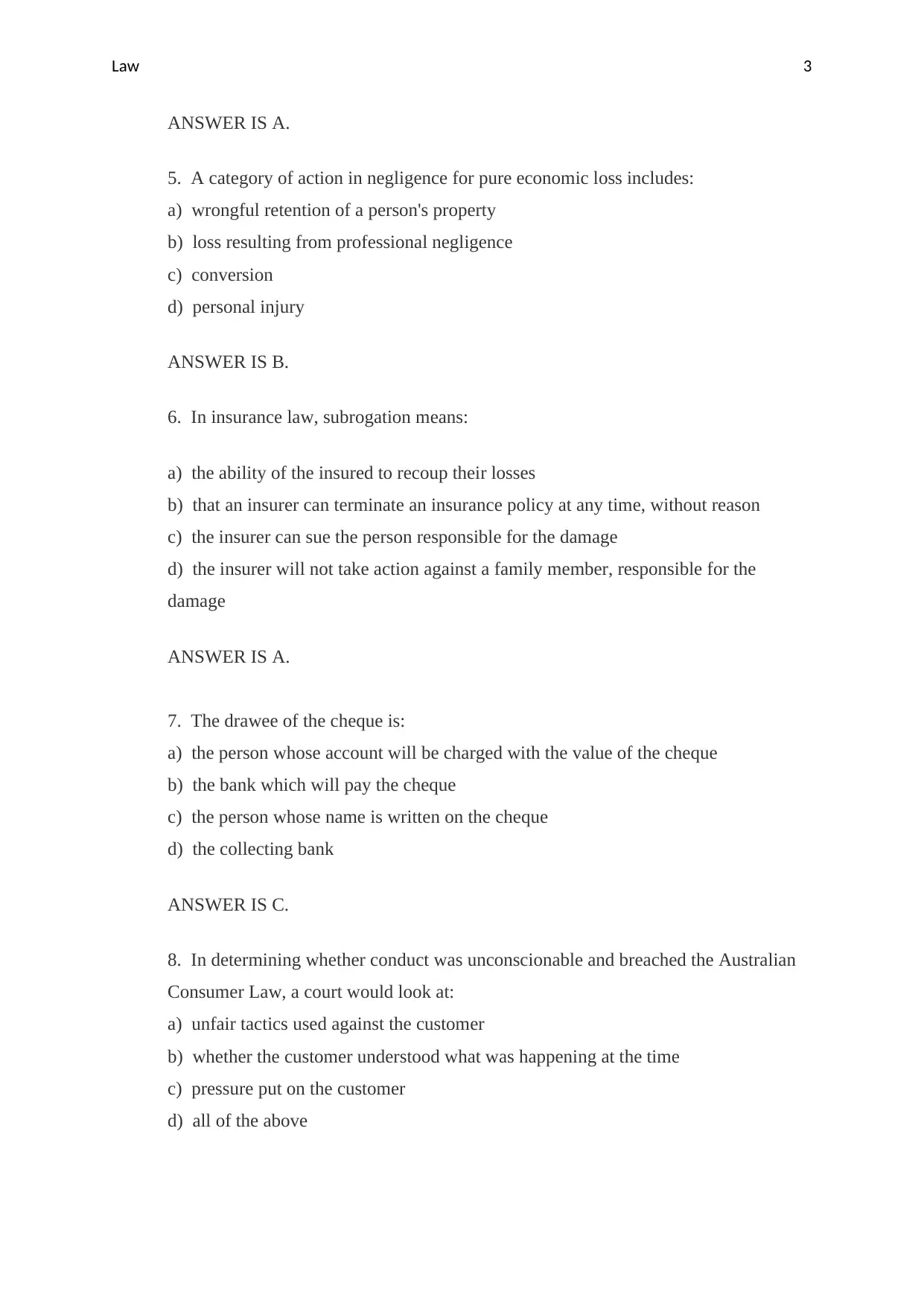
Law 3
ANSWER IS A.
5. A category of action in negligence for pure economic loss includes:
a) wrongful retention of a person's property
b) loss resulting from professional negligence
c) conversion
d) personal injury
ANSWER IS B.
6. In insurance law, subrogation means:
a) the ability of the insured to recoup their losses
b) that an insurer can terminate an insurance policy at any time, without reason
c) the insurer can sue the person responsible for the damage
d) the insurer will not take action against a family member, responsible for the
damage
ANSWER IS A.
7. The drawee of the cheque is:
a) the person whose account will be charged with the value of the cheque
b) the bank which will pay the cheque
c) the person whose name is written on the cheque
d) the collecting bank
ANSWER IS C.
8. In determining whether conduct was unconscionable and breached the Australian
Consumer Law, a court would look at:
a) unfair tactics used against the customer
b) whether the customer understood what was happening at the time
c) pressure put on the customer
d) all of the above
ANSWER IS A.
5. A category of action in negligence for pure economic loss includes:
a) wrongful retention of a person's property
b) loss resulting from professional negligence
c) conversion
d) personal injury
ANSWER IS B.
6. In insurance law, subrogation means:
a) the ability of the insured to recoup their losses
b) that an insurer can terminate an insurance policy at any time, without reason
c) the insurer can sue the person responsible for the damage
d) the insurer will not take action against a family member, responsible for the
damage
ANSWER IS A.
7. The drawee of the cheque is:
a) the person whose account will be charged with the value of the cheque
b) the bank which will pay the cheque
c) the person whose name is written on the cheque
d) the collecting bank
ANSWER IS C.
8. In determining whether conduct was unconscionable and breached the Australian
Consumer Law, a court would look at:
a) unfair tactics used against the customer
b) whether the customer understood what was happening at the time
c) pressure put on the customer
d) all of the above
Paraphrase This Document
Need a fresh take? Get an instant paraphrase of this document with our AI Paraphraser
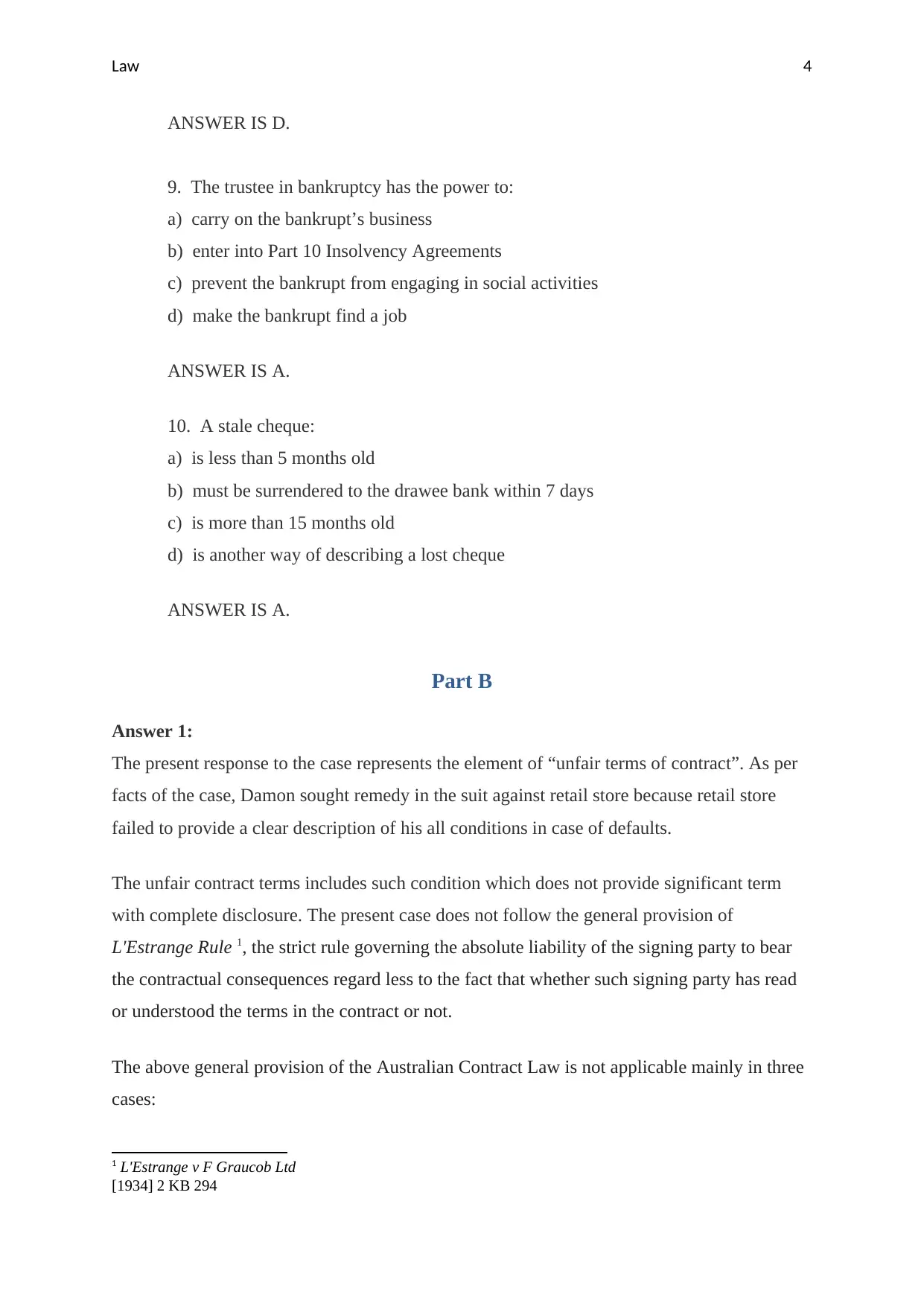
Law 4
ANSWER IS D.
9. The trustee in bankruptcy has the power to:
a) carry on the bankrupt’s business
b) enter into Part 10 Insolvency Agreements
c) prevent the bankrupt from engaging in social activities
d) make the bankrupt find a job
ANSWER IS A.
10. A stale cheque:
a) is less than 5 months old
b) must be surrendered to the drawee bank within 7 days
c) is more than 15 months old
d) is another way of describing a lost cheque
ANSWER IS A.
Part B
Answer 1:
The present response to the case represents the element of “unfair terms of contract”. As per
facts of the case, Damon sought remedy in the suit against retail store because retail store
failed to provide a clear description of his all conditions in case of defaults.
The unfair contract terms includes such condition which does not provide significant term
with complete disclosure. The present case does not follow the general provision of
L'Estrange Rule 1, the strict rule governing the absolute liability of the signing party to bear
the contractual consequences regard less to the fact that whether such signing party has read
or understood the terms in the contract or not.
The above general provision of the Australian Contract Law is not applicable mainly in three
cases:
1 L'Estrange v F Graucob Ltd
[1934] 2 KB 294
ANSWER IS D.
9. The trustee in bankruptcy has the power to:
a) carry on the bankrupt’s business
b) enter into Part 10 Insolvency Agreements
c) prevent the bankrupt from engaging in social activities
d) make the bankrupt find a job
ANSWER IS A.
10. A stale cheque:
a) is less than 5 months old
b) must be surrendered to the drawee bank within 7 days
c) is more than 15 months old
d) is another way of describing a lost cheque
ANSWER IS A.
Part B
Answer 1:
The present response to the case represents the element of “unfair terms of contract”. As per
facts of the case, Damon sought remedy in the suit against retail store because retail store
failed to provide a clear description of his all conditions in case of defaults.
The unfair contract terms includes such condition which does not provide significant term
with complete disclosure. The present case does not follow the general provision of
L'Estrange Rule 1, the strict rule governing the absolute liability of the signing party to bear
the contractual consequences regard less to the fact that whether such signing party has read
or understood the terms in the contract or not.
The above general provision of the Australian Contract Law is not applicable mainly in three
cases:
1 L'Estrange v F Graucob Ltd
[1934] 2 KB 294
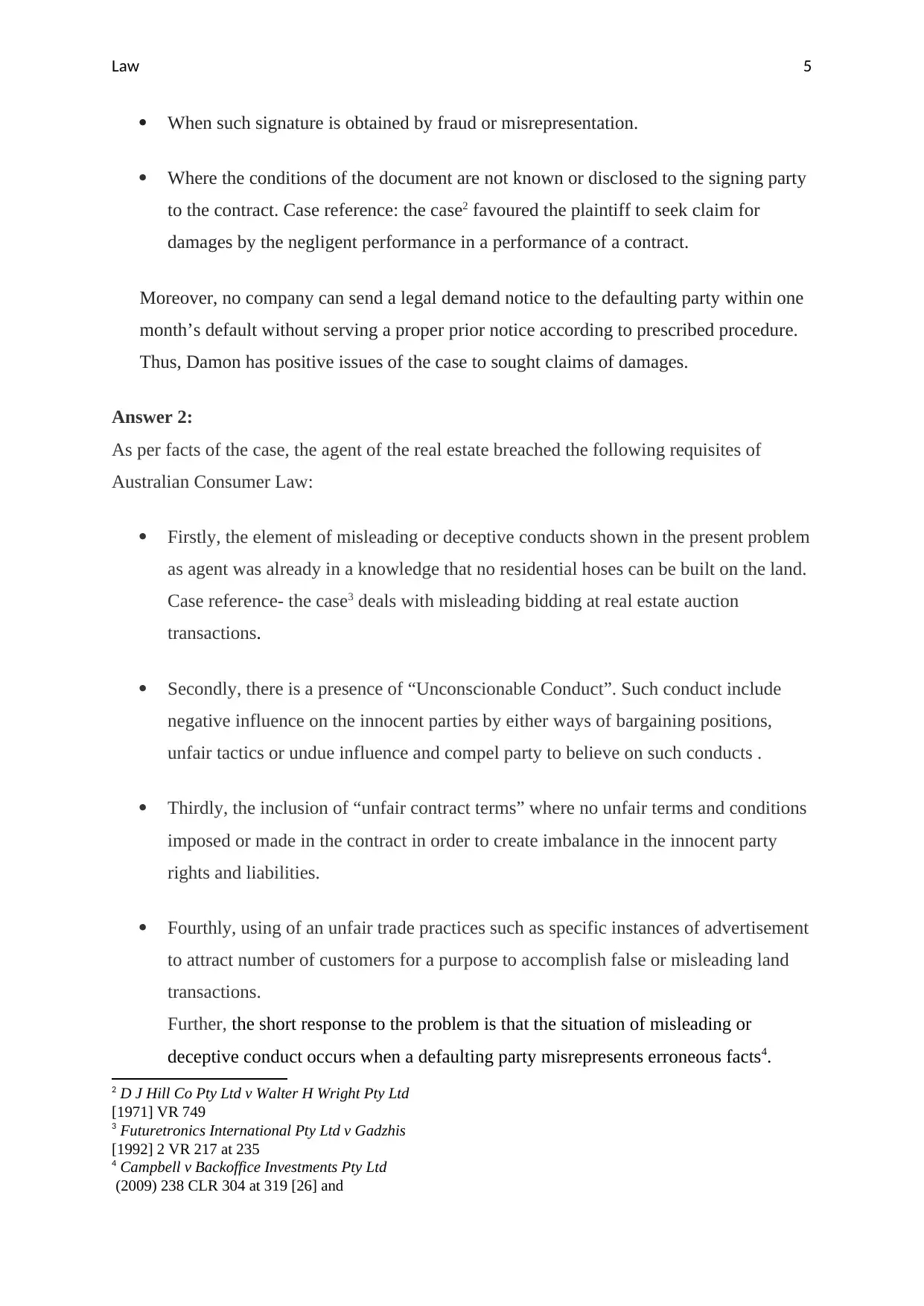
Law 5
When such signature is obtained by fraud or misrepresentation.
Where the conditions of the document are not known or disclosed to the signing party
to the contract. Case reference: the case2 favoured the plaintiff to seek claim for
damages by the negligent performance in a performance of a contract.
Moreover, no company can send a legal demand notice to the defaulting party within one
month’s default without serving a proper prior notice according to prescribed procedure.
Thus, Damon has positive issues of the case to sought claims of damages.
Answer 2:
As per facts of the case, the agent of the real estate breached the following requisites of
Australian Consumer Law:
Firstly, the element of misleading or deceptive conducts shown in the present problem
as agent was already in a knowledge that no residential hoses can be built on the land.
Case reference- the case3 deals with misleading bidding at real estate auction
transactions.
Secondly, there is a presence of “Unconscionable Conduct”. Such conduct include
negative influence on the innocent parties by either ways of bargaining positions,
unfair tactics or undue influence and compel party to believe on such conducts .
Thirdly, the inclusion of “unfair contract terms” where no unfair terms and conditions
imposed or made in the contract in order to create imbalance in the innocent party
rights and liabilities.
Fourthly, using of an unfair trade practices such as specific instances of advertisement
to attract number of customers for a purpose to accomplish false or misleading land
transactions.
Further, the short response to the problem is that the situation of misleading or
deceptive conduct occurs when a defaulting party misrepresents erroneous facts4.
2 D J Hill Co Pty Ltd v Walter H Wright Pty Ltd
[1971] VR 749
3 Futuretronics International Pty Ltd v Gadzhis
[1992] 2 VR 217 at 235
4 Campbell v Backoffice Investments Pty Ltd
(2009) 238 CLR 304 at 319 [26] and
When such signature is obtained by fraud or misrepresentation.
Where the conditions of the document are not known or disclosed to the signing party
to the contract. Case reference: the case2 favoured the plaintiff to seek claim for
damages by the negligent performance in a performance of a contract.
Moreover, no company can send a legal demand notice to the defaulting party within one
month’s default without serving a proper prior notice according to prescribed procedure.
Thus, Damon has positive issues of the case to sought claims of damages.
Answer 2:
As per facts of the case, the agent of the real estate breached the following requisites of
Australian Consumer Law:
Firstly, the element of misleading or deceptive conducts shown in the present problem
as agent was already in a knowledge that no residential hoses can be built on the land.
Case reference- the case3 deals with misleading bidding at real estate auction
transactions.
Secondly, there is a presence of “Unconscionable Conduct”. Such conduct include
negative influence on the innocent parties by either ways of bargaining positions,
unfair tactics or undue influence and compel party to believe on such conducts .
Thirdly, the inclusion of “unfair contract terms” where no unfair terms and conditions
imposed or made in the contract in order to create imbalance in the innocent party
rights and liabilities.
Fourthly, using of an unfair trade practices such as specific instances of advertisement
to attract number of customers for a purpose to accomplish false or misleading land
transactions.
Further, the short response to the problem is that the situation of misleading or
deceptive conduct occurs when a defaulting party misrepresents erroneous facts4.
2 D J Hill Co Pty Ltd v Walter H Wright Pty Ltd
[1971] VR 749
3 Futuretronics International Pty Ltd v Gadzhis
[1992] 2 VR 217 at 235
4 Campbell v Backoffice Investments Pty Ltd
(2009) 238 CLR 304 at 319 [26] and
⊘ This is a preview!⊘
Do you want full access?
Subscribe today to unlock all pages.

Trusted by 1+ million students worldwide
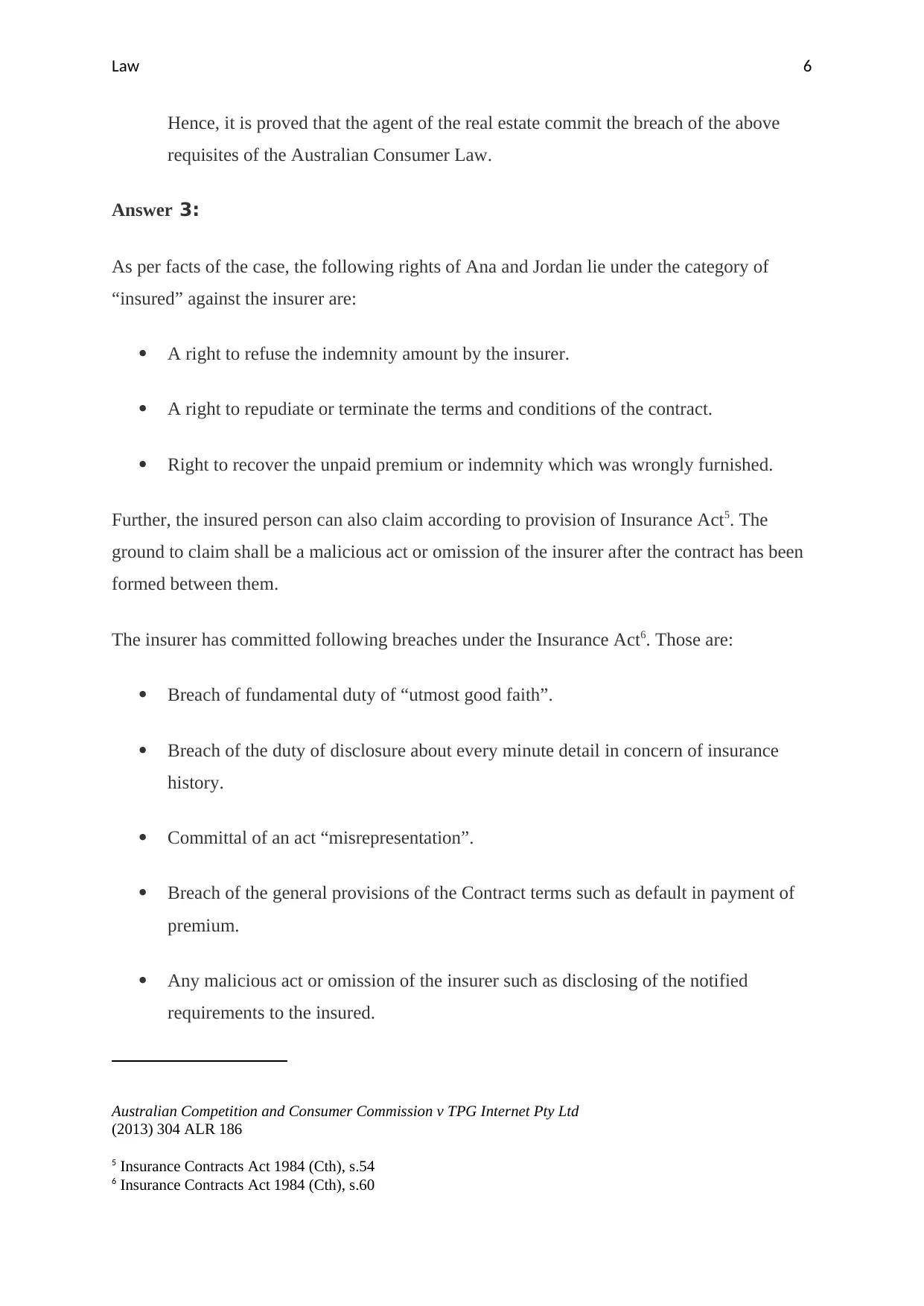
Law 6
Hence, it is proved that the agent of the real estate commit the breach of the above
requisites of the Australian Consumer Law.
Answer 3:
As per facts of the case, the following rights of Ana and Jordan lie under the category of
“insured” against the insurer are:
A right to refuse the indemnity amount by the insurer.
A right to repudiate or terminate the terms and conditions of the contract.
Right to recover the unpaid premium or indemnity which was wrongly furnished.
Further, the insured person can also claim according to provision of Insurance Act5. The
ground to claim shall be a malicious act or omission of the insurer after the contract has been
formed between them.
The insurer has committed following breaches under the Insurance Act6. Those are:
Breach of fundamental duty of “utmost good faith”.
Breach of the duty of disclosure about every minute detail in concern of insurance
history.
Committal of an act “misrepresentation”.
Breach of the general provisions of the Contract terms such as default in payment of
premium.
Any malicious act or omission of the insurer such as disclosing of the notified
requirements to the insured.
Australian Competition and Consumer Commission v TPG Internet Pty Ltd
(2013) 304 ALR 186
5 Insurance Contracts Act 1984 (Cth), s.54
6 Insurance Contracts Act 1984 (Cth), s.60
Hence, it is proved that the agent of the real estate commit the breach of the above
requisites of the Australian Consumer Law.
Answer 3:
As per facts of the case, the following rights of Ana and Jordan lie under the category of
“insured” against the insurer are:
A right to refuse the indemnity amount by the insurer.
A right to repudiate or terminate the terms and conditions of the contract.
Right to recover the unpaid premium or indemnity which was wrongly furnished.
Further, the insured person can also claim according to provision of Insurance Act5. The
ground to claim shall be a malicious act or omission of the insurer after the contract has been
formed between them.
The insurer has committed following breaches under the Insurance Act6. Those are:
Breach of fundamental duty of “utmost good faith”.
Breach of the duty of disclosure about every minute detail in concern of insurance
history.
Committal of an act “misrepresentation”.
Breach of the general provisions of the Contract terms such as default in payment of
premium.
Any malicious act or omission of the insurer such as disclosing of the notified
requirements to the insured.
Australian Competition and Consumer Commission v TPG Internet Pty Ltd
(2013) 304 ALR 186
5 Insurance Contracts Act 1984 (Cth), s.54
6 Insurance Contracts Act 1984 (Cth), s.60
Paraphrase This Document
Need a fresh take? Get an instant paraphrase of this document with our AI Paraphraser
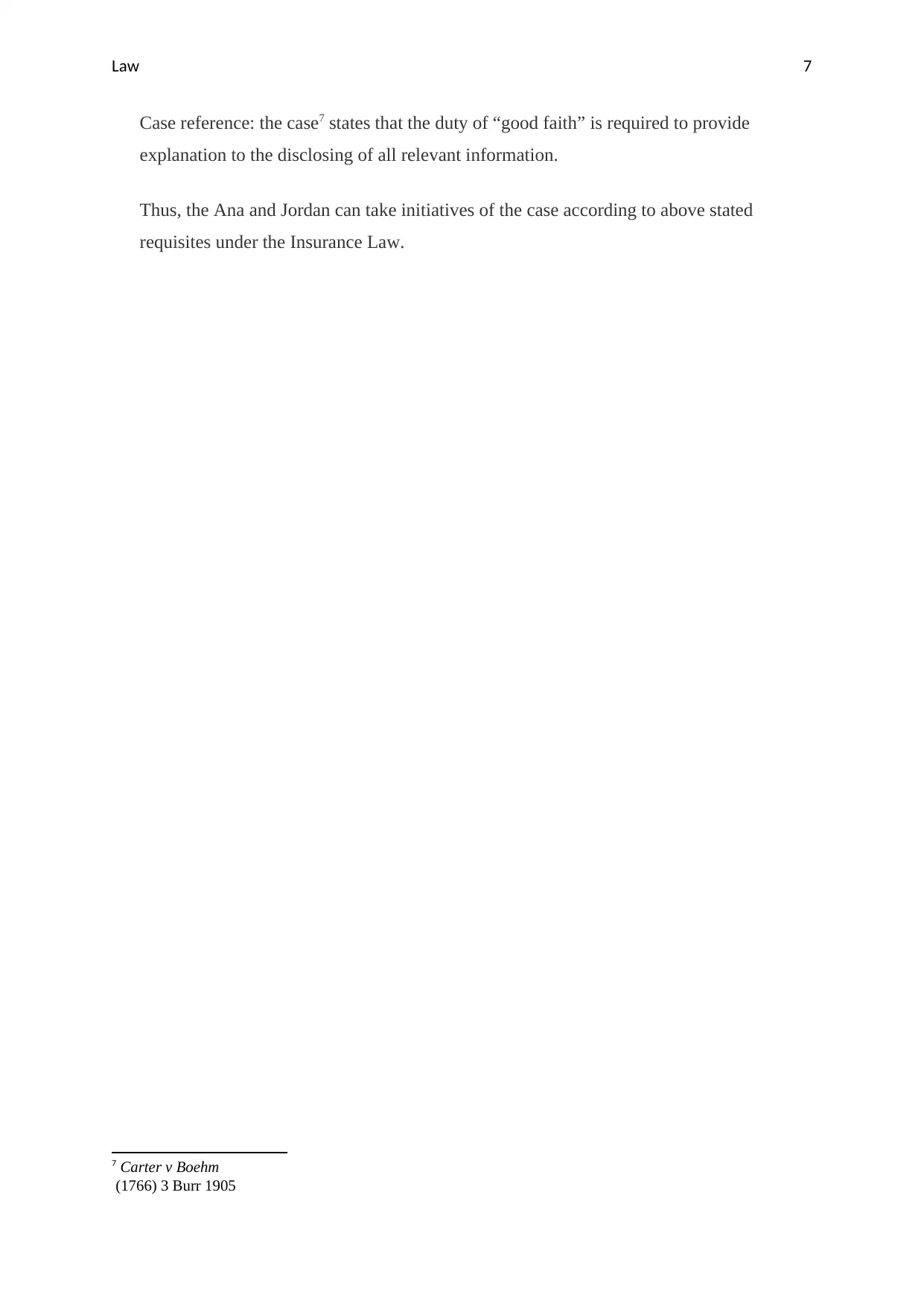
Law 7
Case reference: the case7 states that the duty of “good faith” is required to provide
explanation to the disclosing of all relevant information.
Thus, the Ana and Jordan can take initiatives of the case according to above stated
requisites under the Insurance Law.
7 Carter v Boehm
(1766) 3 Burr 1905
Case reference: the case7 states that the duty of “good faith” is required to provide
explanation to the disclosing of all relevant information.
Thus, the Ana and Jordan can take initiatives of the case according to above stated
requisites under the Insurance Law.
7 Carter v Boehm
(1766) 3 Burr 1905
1 out of 8
Related Documents
Your All-in-One AI-Powered Toolkit for Academic Success.
+13062052269
info@desklib.com
Available 24*7 on WhatsApp / Email
![[object Object]](/_next/static/media/star-bottom.7253800d.svg)
Unlock your academic potential
Copyright © 2020–2025 A2Z Services. All Rights Reserved. Developed and managed by ZUCOL.





